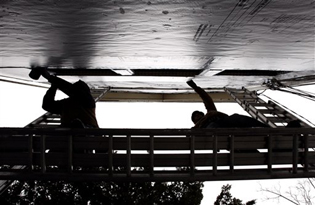| Home | Blog | Ask This | Showcase | Commentary | Comments | About Us | Contributors | Contact Us |

Who will give out the new green jobs? Who will get them?ASK THIS | March 83, 2009The stimulus bill could lead to a million or more “green” jobs, many of them created at the state and local levels. For reporters this is an important story on two levels: keeping track of energy and environmental enhancements as they develop, and the doling out of jobs: how will hiring work? By Judith Bell Q. How much does the stimulus really do for “green jobs”? The $787 billion recovery package marks an historic investment in creating green jobs. The package sets aside tens of billions for public transportation, renewable energy, environmentally-friendly infrastructure projects and job training programs. Overall, about 40 percent of the 2.5 million to 3.5 million jobs created are expected to be “green.” Q. Who is going to get these jobs? Is there anything in the stimulus bill that says where the jobs should go? It’s not clear who will get these jobs. If the money just gets pumped out through the same channels it always has, low-income communities, communities of color and small businesses are almost certainly going to get left out. However, the bill does include some language that could help steer jobs to communities that need them most. The bill calls for the investments to “help those most impacted by the recession” and “invest in transportation, environmental protection and other infrastructure that will provide long-term benefits.” Low-income communities have been particularly hard-hit by job losses and foreclosures – and have suffered from long-term government disinvestment for decades. Aside from a solid prevailing wage requirement for the hundreds of thousands of construction-related jobs created by the bill, though, there are few provisions that single out lower-income people, such as local hiring requirements or workforce training programs. With the bulk of spending decisions expected to be made at the state and local levels (as well as inside federal agencies), it is up to legislators and advocates to ensure the jobs go to those who need them the most. Q. How can regular people make a difference in where the jobs go? Isn’t it too late already? This is one of the most misunderstood parts of the stimulus bill. While the bill allocated money in broad brushstrokes, many of the real spending decisions will happen on the state and local levels. Since the bill didn’t have any earmarks, states and localities are freer than most people realize to spend the money in ways they think will be most beneficial to their communities. That is not to say the money can be spent entirely without strings or federal guidance, but state and local governments have significant discretion in many spending areas. Organized local advocates – and dedicated watchdog reporters – can have an enormous impact on the spending decisions. Without community involvement and oversight, in fact, much of the money will likely miss the neighborhoods that have been hit “first and worst” in the crisis – primarily low-income communities. A report released last week by PolicyLink and Green for All shows exactly how advocates can push the right levers to get the jobs and investments directed to those who need them most. Click here to read the full report, “Bringing Home the Green Recovery: A User’s Guide to the 2009 American Recovery and Reinvestment Act.” (NOTE: Shortly after the release of the report, Green for All founder and CEO Van Jones was tapped to be President Obama’s top green jobs adviser.) Q. What will happen if regular people and the media don’t get involved? Because the majority of recovery dollars are heading out to states and localities at “lightning speed” (for public policy, at least), there is a significant danger that back-room deals and pet projects will win out, rather than projects that benefit communities most in need. There is, of course, no question the package includes oversight and accountability measures. But advocates and residents must demand fully open, accountable and transparent spending processes that allow the voices of people facing economic hardships to be heard. The first step may seem like a simple one: demand public hearings. By just forcing the government to do the public’s business in the open and hear from residents most affected, more may start flowing to the communities that need it most. If elected officials won’t convene public meetings, however, communities should organize their own town halls, and news reporters should cover them. Enabling community residents a public forum to discuss their needs—and bring attention to it—will help develop a baseline to judge future spending against. Q. Are there any green-jobs projects that would be particularly helpful for low-income communities? The Weatherization Assistance Program – targeted specifically at low-income neighborhoods – has been remarkably successful in helping weatherize homes across the nation. These projects can have the double-benefit of reducing long-term energy costs for homeowners and renters and creating jobs for community residents. In my view, there should be local hiring mandates so that the jobs stay in the community. These would be tangible improvements in employment and community life that people can really see and feel. Advocates and residents also can push to have job training and apprenticeship programs included as part of the weatherization projects. They offer a prime opportunity to engage labor unions and community colleges in training the next generation of American workers in green, cost-effective building. By building in local hiring requirements, these jobs can be vital to ensuring the long-term stability and prosperity of our communities. Q. Is there a role for the press in seeing how resources get to communities? The answer is yes, regardless of whether you’re a journalist who is reporting the news, or an advocate promoting a special cause. Reporters and editors, in localities across the country, need to understand the importance of the green aspect of the economic recovery and to cover it as it develops. It’s a very good story and one that will continue to develop over time. Labor markets will continue to change as the economy changes. And, later this year, the Congress is slated to take up comprehensive climate change legislation. Green jobs promise to be a part of that debate too. A good start, for journalists as well as advocates, is the PolicyLink/Green for All user’s guide to the stimulus bill. It has a program-by-program breakdown of the green jobs sections of the stimulus, and shows exactly where vital decisions about these jobs will be made.
|




